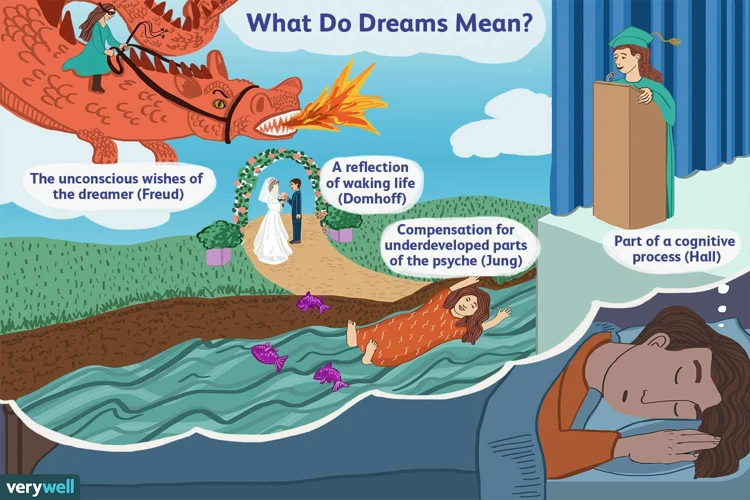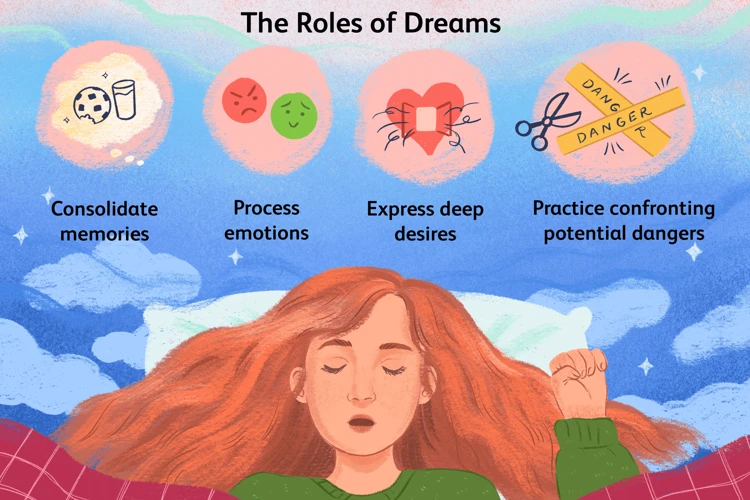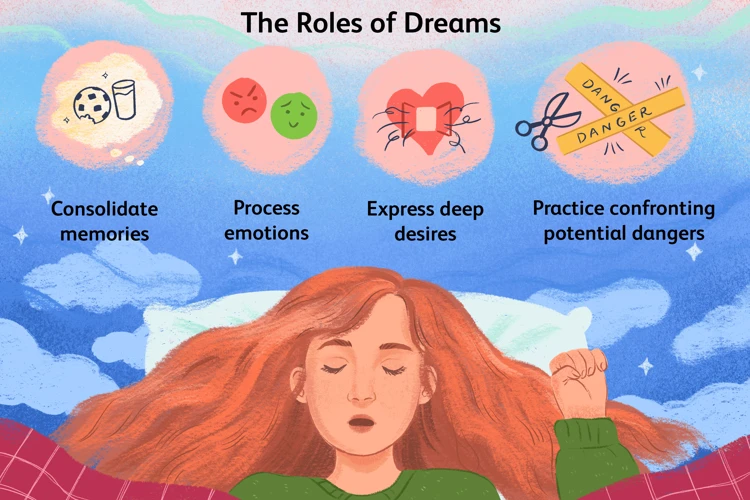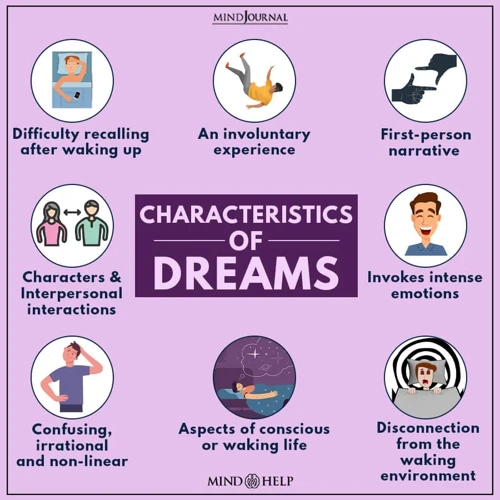Are our dreams simply random and meaningless, or do they hold a deeper connection to our emotions? The intricate relationship between dreams and emotions has long fascinated scientists, psychologists, and dream enthusiasts alike. We have all experienced vivid dreams that provoked strong emotions, whether it’s joy, fear, or sadness. Dreams have the power to transport us to other worlds, confront our deepest fears, and bring to light our unexpressed desires. In this article, we will delve into the connection between dreams and emotions, exploring the significance of dreams, the science behind dreaming, common dream themes and their emotional meanings, decoding emotions in dreams, and the impact of emotions in dreams on our waking life. So, prepare to embark on a journey of self-discovery as we unravel the mysteries of our dream world and its profound influence on our emotions.
The Significance of Dreams

Dreams have captivated humans since ancient times, and their significance spans across cultures and generations. They are often seen as windows into our subconscious mind, providing insights into our deepest thoughts, emotions, and desires. Dreams have been attributed with the power to offer guidance, provide healing, and even predict the future. Many ancient civilizations believed that dreams were messages from the gods or spirits. In modern times, the significance of dreams has been explored through various psychological and scientific perspectives. One prominent theory is that dreams serve as a way to process and integrate our daily experiences and emotions. They may help us make sense of our waking life by allowing us to explore unresolved conflicts, express repressed emotions, and gain new perspectives. Dreams can also provide a safe space for us to confront fears, test out potential scenarios, and problem-solve. The significance of dreams lies in their ability to serve as a source of personal insight, emotional release, and psychological growth. They offer a unique window into the inner workings of our minds and hearts, illuminating the often mysterious connection between our dreams and our waking life experiences. To fully understand the significance of dreams, we must explore their role in emotional well-being, the interpretation of dream symbols, and the impact of nightmares on our emotional states.
Link: exploring the connection between dream emotions and waking life experiences
The Science Behind Dreaming

The science behind dreaming is a complex and fascinating field of study that continues to intrigue researchers and experts in the field of neuroscience. Dreams primarily occur during the rapid eye movement (REM) stage of sleep, which is characterized by increased brain activity and vivid imagery. During REM sleep, the brain’s frontal lobes, responsible for logical thinking and decision-making, are less active, while the limbic system, which governs emotions and memories, becomes highly active. This suggests that dreams are intricately linked to our emotional experiences and memories. Research has shown that dreaming plays a crucial role in emotional processing, memory consolidation, and creative problem-solving. Dreams may act as a way for the brain to process and make sense of our daily experiences, regulate emotions, and integrate new information. While the exact purpose of dreaming is still not fully understood, current scientific theories indicate that dreams serve important functions in our cognitive and emotional well-being.
Link: nightmares and emotional well-being
1. REM Sleep and Emotional Processing
During REM (Rapid Eye Movement) sleep, our brain is highly active, and this stage of sleep is closely linked to emotional processing. REM sleep is characterized by fast and random eye movements, vivid dreaming, and an increase in brain activity levels. Scientists believe that REM sleep plays a crucial role in regulating our emotions and consolidating emotional memories. It is during this phase that our brain processes and integrates the emotional experiences we have encountered during the day.
The amygdala, a small almond-shaped structure in the brain, is particularly active during REM sleep. The amygdala is known to play a key role in processing emotions and generating emotional responses. Research suggests that during REM sleep, the amygdala helps to stimulate emotional memories and reactivate neural pathways associated with emotional experiences. This may explain why dreams often evoke strong emotions and why certain emotional memories may resurface during sleep.
Studies have shown that the brain regions involved in emotional processing, such as the prefrontal cortex, become disconnected from the regions responsible for rational thinking and decision-making during REM sleep. This disconnection allows for a more fluid and creative exploration of emotions in dreams, where boundaries and limitations are less prominent. This may contribute to the heightened emotions experienced during dreams and the ability to process and make sense of complex emotions in a symbolic and metaphoric way.
Understanding the connection between REM sleep and emotional processing provides valuable insights into why dreams can elicit intense emotional responses. It highlights the importance of this sleep stage in consolidating and integrating emotional experiences. By decoding and analyzing the emotional content of dreams, we can gain a deeper understanding of our own emotional states and potentially uncover unresolved emotions that require attention and resolution.
Link: interpreting dream symbols and their connection to emotions
2. Role of the Amygdala in Emotion and Dream Content
The amygdala, a small almond-shaped structure located deep within the brain, plays a crucial role in both emotion and dream content. As the brain’s emotional center, the amygdala is responsible for processing and regulating emotional responses. It is highly interconnected with other regions of the brain, such as the hippocampus and prefrontal cortex, forming a complex network involved in emotional processing. Research has shown that the amygdala is activated during emotional experiences, including fear, pleasure, and arousal. Interestingly, studies have also found that the amygdala remains active during certain stages of sleep, particularly during REM (rapid eye movement) sleep, which is when dreams predominantly occur.
During REM sleep, the amygdala influences the content and intensity of our dreams. It is believed that the emotional memories and experiences stored in the amygdala are replayed and integrated into dream narratives. This suggests that the amygdala acts as a gateway for emotional information to enter the dream world. The activation of the amygdala during REM sleep may explain why dreams often evoke strong emotions, such as fear or happiness.
The amygdala’s role in the processing of emotions can also contribute to the formation of dream themes and imagery. For example, if a person experiences a traumatic event, the emotional impact of that event may seep into their dreams, manifesting as nightmares or distressing dream content. Similarly, positive emotions experienced during wakefulness can also be reflected in dreams, leading to pleasant and uplifting dream experiences.
Understanding the role of the amygdala in emotion and dream content provides valuable insights into the intricate connection between our emotional experiences and dreamland. It highlights the influence of emotions on dream formation and suggests that exploring and decoding the emotional content of dreams can provide valuable information about our psychological well-being. By studying the role of the amygdala in dreams, researchers can gain a deeper understanding of the complex interplay between our emotions, dreams, and overall mental health.
Common Dream Themes and Emotional Meanings

In the realm of dreams, certain themes tend to recur, and each theme carries its own emotional meaning. Understanding these common dream themes can offer valuable insights into our emotional state and underlying concerns. One prevalent theme is “falling,” which often reflects feelings of insecurity and a lack of control in our waking life. Dreams of “flying” typically represent a sense of freedom, empowerment, and the ability to rise above challenges. Being “chased” in dreams is often associated with anxiety and a fear of being pursued or overwhelmed. Another common dream theme is “being naked,” which symbolizes vulnerability and a fear of being exposed or judged. These emotional meanings of common dream themes can provide clues about our subconscious worries, desires, and unresolved emotions. By unraveling the emotional significance behind our dreams, we can gain a deeper understanding of ourselves and our emotional well-being.
1. Falling and Insecurity
When it comes to dream themes and their emotional meanings, one common example is the sensation of falling, which is often associated with feelings of insecurity and lack of control. Dreaming about falling can evoke a sense of vulnerability and fear, as if life is spiraling out of control. These dreams may reflect underlying anxieties or insecurities in our waking life. The feeling of falling can symbolize a fear of failure or a lack of self-confidence. It may indicate that we are feeling overwhelmed or uncertain about our ability to navigate life’s challenges. These dreams can be especially common during times of transition or when facing significant changes or uncertainties in our lives. While falling dreams may be unsettling, they can also serve as an opportunity for self-reflection and introspection. They can prompt us to examine the areas in our lives where we feel insecure and empower us to address these concerns. By acknowledging our fears and insecurities, we can work towards building self-confidence and finding stability amidst uncertainty.
Link: none
2. Flying and Freedom
Dreams of flying have long been associated with a sense of freedom, liberation, and empowerment. When we dream of soaring through the sky, effortlessly defying gravity, it is often a reflection of our desire to break free from limitations or constraints in our waking life. Flying dreams can be exhilarating experiences, where we feel a sense of euphoria and liberation. Symbolically, flying represents the ability to rise above challenges, overcome obstacles, and gain a fresh perspective. It can also signify a sense of empowerment and the belief that anything is possible. Flying dreams can be particularly significant for individuals who feel trapped or restricted in their daily lives. Such dreams may serve as a reminder that they have the power to transcend limitations, embrace their true potential, and pursue their aspirations with freedom and confidence. Additionally, flying dreams can evoke feelings of joy, excitement, and a sense of adventure. They can be a source of inspiration and encourage us to explore new horizons, take risks, and live life to the fullest. Flying dreams are not only an exhilarating experience within the dream world but also carry profound emotional and symbolic meanings that can inspire us to embrace our inner sense of freedom and pursue our dreams in waking life.
Link: interpreting dream symbols and emotions
3. Being Chased and Anxiety
Being chased in a dream is a common theme that often evokes feelings of anxiety and fear. This dream scenario can take many forms, such as being pursued by a person, animal, or even an unknown force. The experience of being chased in a dream is symbolic of avoiding or running away from something in our waking life that is causing us stress or anxiety. It may reflect a sense of being overwhelmed by responsibilities, deadlines, or expectations. Alternatively, it could represent unresolved conflicts or past traumas that we have not fully confronted or addressed. The feeling of being chased in a dream can be a manifestation of our subconscious mind urging us to confront these anxieties and fears head-on. It serves as a reminder that we cannot continue to evade or ignore our problems; instead, we must face them in order to find resolution and inner peace. This dream theme can also be an indication that we may be running away from our own emotions or avoiding difficult conversations or situations in our waking life. It is a call to acknowledge and address our anxieties, as well as to seek support and guidance in navigating them. By exploring the meaning behind being chased in our dreams, we can gain insight into the underlying sources of our anxieties and take proactive steps towards managing and reducing them.
Link: nightmares and their impact on emotional well-being
4. Being Naked and Vulnerability
Being naked in a dream can evoke intense emotions and often symbolizes vulnerability. When we dream of being naked, it represents the feeling of being exposed, unprotected, and open to judgment. This dream theme can stem from a variety of emotions and situations in our waking life. It may signify feelings of insecurity, low self-esteem, or fear of being judged or criticized by others. Being naked in a dream can also reflect a desire for authenticity and a need to break free from societal expectations or constraints. It may indicate a longing to express our true selves without fear of rejection or shame. Additionally, being naked in a dream can be associated with a sense of liberation and a desire for self-acceptance. It may prompt us to embrace our flaws, vulnerabilities, and imperfections, reminding us that true beauty lies in our authenticity. Understanding the emotional meaning behind the dream of being naked allows us to explore our fears, insecurities, and desires for acceptance. It encourages us to reflect on our self-image and the impact of societal norms on our sense of self-worth. By acknowledging and addressing these emotions, we can cultivate a greater sense of self-acceptance, redefine our perception of vulnerability, and find the strength to embrace our authentic selves.
Link: interpreting dream symbols and emotions
Decoding Emotions in Dreams

Decoding emotions in dreams is like unraveling the intricate threads of a tapestry, as our dreams often express and reflect our deepest emotional states. Dreams can be complex and filled with symbolism, making it a fascinating challenge to decipher their underlying emotions. One way to decode emotions in dreams is by analyzing the various dream symbols and their subjective meanings. Symbols in dreams can represent different emotions depending on personal experiences and cultural influences. For example, a dream about water may symbolize emotions such as peace, tranquility, or purification. Another approach to decoding emotions in dreams is recognizing the symbolic representations of emotions themselves. Dreams often use metaphorical language to express our innermost feelings. An intense feeling of fear in a dream may symbolize a deep-seated anxiety or insecurity in waking life. By exploring the emotions embedded within our dreams, we gain valuable insights into our subconscious mind and the emotional landscape of our waking selves.
1. Analyzing Dream Symbols
When it comes to analyzing dream symbols, it’s important to understand that each symbol can carry multiple interpretations depending on the individual and their personal experiences. No dream symbol has a fixed meaning that applies to everyone. Analyzing dream symbols involves exploring both the universal and personal associations that a symbol may hold.
One way to analyze dream symbols is to create a dream journal. This involves recording your dreams and noting down the symbols that appear. By keeping a detailed record, you can start to identify recurring symbols or patterns that may hold significance in your dreams. For example, seeing water in a dream could represent emotions, while a snake might symbolize transformation or hidden fears. It’s essential to consider the context and emotions attached to these symbols.
Another approach to analyzing dream symbols is to draw connections between the dream symbols and your waking life. Ask yourself what each symbol means to you personally. For instance, if you dream of a staircase, consider what it represents in your life—progress, growth, or perhaps an obstacle you need to overcome. By drawing parallels between dream symbols and your waking life, you can uncover deeper meanings and messages that your dreams are conveying.
It’s important to note that dream symbols can also be influenced by cultural and societal contexts. Symbols can hold different meanings across various cultures and may be influenced by shared beliefs or experiences. If you come across a symbol that seems perplexing or ambiguous, consider researching its cultural significance to gain a broader perspective.
Analyzing dream symbols requires an open mind and a willingness to explore the layers of meaning within your dreams. Remember, the interpretation of symbols is subjective, and only you hold the key to unlocking the personal significance they hold in your dreams.
Analyzing Dream Symbols:
- Keep a dream journal and record symbols that appear in your dreams
- Identify recurring symbols or patterns
- Consider the context and emotions attached to each symbol
- Draw connections between dream symbols and your waking life
- Explore the personal meaning of each symbol
- Research cultural significance for symbols that are perplexing or ambiguous
2. Recognizing Symbolic Representations of Emotions
Recognizing symbolic representations of emotions in dreams can provide valuable insights into our subconscious mind. Emotions in dreams are often disguised through symbolism, requiring us to decipher their hidden meaning. One common symbol is water, which can represent our emotions and the fluidity of our feelings. For instance, calm and clear water may indicate a sense of tranquility, while turbulent or murky water could signify emotional turmoil or confusion. Another symbol frequently encountered in dreams is fire, which can represent passion, transformation, or even anger. The intensity and behavior of the fire can give clues about the emotional context. Additionally, animals can symbolize various emotions in dreams. For example, a playful and friendly dog may represent joy and companionship, while a menacing snake could symbolize fear or hidden threats. It's important to note that the interpretation of dream symbols can be highly personal and subjective, as their meanings may vary based on an individual's cultural background, personal experiences, and beliefs. Keeping a dream journal and reflecting on the emotions evoked by specific symbols can help in recognizing patterns and understanding the emotional significance embedded in our dreams.
Example html list:
- Water: Represents emotions and their fluidity
- Fire: Symbolizes passion, transformation, or anger
- Animals: Can represent various emotions based on their behavior
The Influence of Emotions on Dream Recall

The emotions we experience during our waking life can play a significant role in our ability to recall dreams. Research suggests that intense emotions, both positive and negative, can enhance dream recall. When we experience strong emotions, the emotional centers of our brain become activated and can influence the encoding and storage of dream memories. Emotions such as excitement, fear, joy, or sadness can act as emotional tags, making the dream content more memorable and easier to recall upon waking. On the other hand, if we wake up feeling emotionally neutral, it may be more difficult to remember our dreams.
Studies have shown that certain types of dreams are more likely to be remembered based on the emotions they evoke. For example, nightmares, which tend to be emotionally intense and often involve threatening or distressing situations, are more likely to be remembered due to the heightened emotional arousal they trigger. Similarly, dreams that elicit strong positive emotions, such as dreams of success or happiness, are also more likely to be recalled.
Our emotional state upon awakening can also impact dream recall. If we wake up abruptly from a vivid or emotionally charged dream, we are more likely to remember it compared to waking up gradually or from a lighter sleep cycle. Additionally, the act of immediately expressing and reflecting on our emotions upon waking can increase dream recall. Keeping a dream journal by our bedside and writing down our emotions and dream content immediately upon waking can help solidify the memory of our dreams and make them easier to recall later.
Emotions play a crucial role in dream recall. Strong emotions serve as emotional tags that enhance the encoding and storage of dream memories, making them more memorable and easier to remember upon waking. Additionally, the emotional intensity of dreams, such as nightmares or dreams that evoke positive emotions, can also impact dream recall. By acknowledging and reflecting on our emotions and keeping a dream journal, we can cultivate a greater awareness of our dream experiences and improve our ability to recall them.
How Emotions in Dreams Affect Our Waking Life

The emotions experienced in dreams have a profound impact on our waking life, shaping our thoughts, behaviors, and overall emotional well-being. When we wake up from a dream filled with intense emotions, whether it be joy, fear, or sadness, those emotions can linger throughout the day, influencing our mood and outlook. Dreams provide a unique opportunity for us to explore and process emotions that may be difficult to confront in our waking life. For example, if we experience a dream where we are overcome with fear, it may indicate underlying anxieties or unresolved issues that we need to address. By recognizing and examining these emotions in our dreams, we can gain valuable insights into our subconscious and make positive changes in our waking life. Emotions in dreams can also serve as a powerful catalyst for personal growth, allowing us to confront and overcome emotional challenges. Dreams can offer a sense of emotional release, providing a safe space for us to express and process deep-seated emotions that may be suppressed during our waking hours. Whether it's through catharsis, problem-solving, or healing trauma, the emotions experienced in dreams have a far-reaching impact on our waking life, guiding us towards greater emotional awareness and well-being.
1. Emotional Catharsis and Release
Emotional catharsis and release are key aspects of the connection between dreams and emotions. Dreams provide us with a unique opportunity to channel and release pent-up emotions that may be difficult to express in our waking life. During dreaming, our minds are uncensored and free to explore the depths of our emotions without judgment or inhibition. This can lead to a cathartic experience where we can safely express and process intense feelings such as grief, anger, or sadness. Dreams offer a release valve for emotional tension, allowing us to purge and let go of negative emotions that may be weighing us down. This emotional catharsis can have a profound impact on our well-being, leaving us feeling lighter, more balanced, and better equipped to navigate our waking life. It is important to note that emotional catharsis in dreams does not necessarily mean that the emotions are completely resolved; rather, it provides a necessary outlet and initiates the process of emotional healing. By allowing ourselves to fully experience and release emotions in our dreams, we pave the way for emotional growth and a healthier emotional state both during sleep and upon waking. Dreams act as a powerful tool for emotional catharsis, providing us with a safe space to express and release our innermost feelings, ultimately contributing to our overall emotional well-being.
2. Emotional Processing and Problem Solving
Emotional processing and problem-solving is a fascinating aspect of dreams that highlights their significance in our daily lives. While we sleep, our minds have the incredible ability to work through complex emotions and tackle real-life problems through the veil of dreams. When we encounter challenging situations during our waking life, our emotions can become overwhelming, clouding our judgment and hindering our ability to find solutions. However, dreams offer us an opportunity to process these emotions in a safe and controlled environment. During REM sleep, the stage of sleep where most dreams occur, our brains are highly active, and the emotional centers of our brain, such as the amygdala, are engaged. This activation allows us to relive and re-experience emotional events, providing an outlet for emotional release and resolution. Through dreams, we can explore different perspectives, test out potential solutions, and gain valuable insights without the constraints and limitations of reality. Dreams can present us with symbolic representations of our emotional struggles and provide a platform for creative problem-solving. By tapping into our subconscious mind, we can uncover hidden emotions, identify patterns and triggers, and develop strategies to overcome challenges in our waking life. As we wake up from a dream, we may find a newfound clarity and a fresh perspective on the emotional issues we were grappling with. This allows us to approach our problems with a renewed sense of understanding and resilience. Emotionally processing and problem-solving in dreams can be a powerful tool for personal growth and self-discovery as we navigate the complexities of our lives.
Link: interpreting dream symbols and emotions
3. Emotional Healing and Trauma Recovery
Emotional healing and trauma recovery can be a long and challenging process, and dreams can play a significant role in this journey. Traumatic experiences can leave deep emotional scars that may manifest in recurring nightmares, flashbacks, or intrusive thoughts. During sleep, our brains have the opportunity to process and integrate these traumatic memories in a safe and controlled environment. Dreams can serve as a platform for emotional healing by allowing us to confront and reprocess the traumatic events at our own pace. In these dreams, we may experience different scenarios or outcomes, providing a sense of control and empowerment that may be lacking in real life. By facing the emotions associated with the traumatic experience, dreams can help us release pent-up feelings and facilitate the healing process.
Dreams can also provide a space for self-reflection and exploration of our emotions in a safe and supportive environment. Through the symbolism and narrative of our dreams, we can gain insights into the underlying causes and effects of our traumas. This self-awareness is crucial for identifying triggers, understanding patterns of behavior, and working towards healing and recovery. Additionally, dreams can offer opportunities for resolution and closure by allowing us to experience alternative endings or scenarios that bring a sense of peace and closure to the traumatic event.
In some cases, professional therapy or counseling may be necessary to support the healing process. Therapists trained in dream analysis can help individuals explore and understand their dreams to better navigate their emotional healing journey. Through guided exploration and interpretation of dream symbols and themes, therapists can assist individuals in uncovering and working through deep-seated emotions associated with their trauma. This therapeutic approach helps individuals gain a deeper understanding of their emotional responses and supports their journey towards healing and recovery.
It's important to note that while dreams can contribute to emotional healing and trauma recovery, they are not a replacement for professional care. If you or someone you know is struggling with trauma-related emotions, it's essential to seek support from qualified mental health professionals who can provide the necessary guidance and treatment.
Link: interpreting dream symbols and their connection to emotions
Lucid Dreaming and Emotional Exploration

Lucid dreaming, a fascinating phenomenon where individuals become aware that they are dreaming while the dream is still occurring, offers a unique opportunity for emotional exploration. In a lucid dream, the dreamer gains control over their actions, surroundings, and even their emotions. This heightened sense of awareness allows individuals to consciously engage with their dreams and delve into their emotional experiences on a deeper level. By recognizing that they are in a dream state, lucid dreamers can actively shape their dreams and intentionally explore their emotions. This exploration can involve directly engaging with difficult emotions, such as fear or sadness, and consciously working through them within the dream. Lucid dreaming also allows individuals to revisit positive emotions and relive joyful experiences, providing a sense of emotional rejuvenation and inspiration.
One technique used in lucid dreaming for emotional exploration is called dream incubation. Dream incubation involves setting an intention before sleep to dream about a specific emotion or emotional situation. By focusing on this intention and practicing certain techniques, such as visualization or affirmations, individuals can increase their chances of having a dream that focuses on the desired emotion. This intentional exploration of emotions in lucid dreams can lead to a deeper understanding of oneself, increased emotional intelligence, and even therapeutic insights. Lucid dreamers may find themselves gaining new perspectives on their emotions, discovering hidden desires or fears, and finding creative solutions to emotional challenges.
It is worth noting that while lucid dreaming can provide a powerful platform for emotional exploration, it requires practice and patience to achieve lucidity. Various techniques, such as reality checks, mindfulness practices, and dream journaling, can help individuals develop the skill of lucid dreaming. Additionally, maintaining a healthy sleep routine and ensuring quality sleep can enhance the likelihood of lucid dreaming experiences.
Lucid dreaming offers a remarkable opportunity for individuals to actively engage with their emotions within the realm of dreams. It enables emotional exploration, personal growth, and can even be used as a tool for therapeutic purposes. By harnessing the power of lucid dreaming, individuals can unlock a deeper understanding of themselves and their emotions, leading to greater emotional well-being and self-discovery.
Using Dreams to Understand and Heal Emotions
Our dreams can serve as a powerful tool for understanding and healing our emotions. When we pay attention to the symbols, themes, and emotions present in our dreams, we gain valuable insights into our unconscious thoughts and feelings. By keeping a dream journal and reflecting on our dreams, we can uncover patterns and recurring themes that may be indicative of underlying emotional issues. Dream analysis and therapy provide a structured approach to exploring the deeper meanings behind our dreams, allowing us to gain a deeper understanding of ourselves and our emotional landscape. Incorporating dreams into our emotional well-being practices, such as meditation, visualization, or journaling, can facilitate healing and personal growth. Using dreams as a tool for understanding and healing emotions allows us to tap into the wisdom of our subconscious mind and embark on a transformative journey towards emotional well-being.
1. Dream Journals and Reflection
Dream Journals and Reflection are powerful tools for understanding and harnessing the emotional content of our dreams. Keeping a dream journal involves recording our dreams immediately upon waking, capturing as many details as possible. It serves as a valuable resource for later reflection and analysis. By writing down our dreams, we reinforce our commitment to exploring and understanding their emotional significance. Dream journals help us develop better dream recall as we train ourselves to remember and document our dreams consistently.
When using a dream journal, it's essential to include sensory elements, emotions, and any notable symbols or themes. This process helps us identify patterns and recurring symbols in our dreams, allowing us to unravel their deeper meanings. Reflecting on our dream journal entries over time may reveal connections between our dreams and our waking life experiences, shedding light on unresolved emotions or themes that require attention.
To enhance the effectiveness of dream journaling and reflection, it can be helpful to establish a consistent bedtime routine that includes relaxation techniques and setting the intention to remember and explore dreams. By creating a peaceful and conducive sleep environment, we promote more vivid and memorable dreams. Additionally, incorporating mindfulness and meditation practices during waking hours can cultivate a greater awareness of our emotions, making it easier to identify and process them within our dreams.
Dream journaling and reflection can be complemented by the use of imagery and creativity. Drawing or painting scenes from our dreams can tap into our subconscious mind and facilitate a deeper understanding of the emotional symbolism present. Engaging in interpretive exercises, such as writing poetry inspired by dream imagery or discussing dreams with others in a support group, can also provide fresh perspectives and insights.
Dream journals and reflection offer a structured and introspective approach to delve into the emotional landscape of our dreams. Through consistent documentation, analysis, and creative exploration, we can unlock the hidden meanings and emotional content buried within our dreams. This process ultimately empowers us to integrate our dream experiences into our waking life, leading to personal growth and emotional well-being.
2. Dream Analysis and Therapy
Dream analysis and therapy have long been utilized as valuable tools for understanding the deeper meaning and significance of our dreams. It involves a systematic approach to interpreting the symbols, emotions, and narratives present in our dreams in order to gain insights into our unconscious thoughts and emotions. Dream analysis can be done individually or with the guidance of a trained therapist who specializes in dream work. Through this process, individuals are encouraged to explore the personal associations and meanings behind the elements in their dreams, as well as the emotions evoked during the dream experience.
Dream analysis and therapy can provide a multitude of benefits. It can help individuals gain a deeper understanding of their unconscious desires, fears, and conflicts. It can also offer clarity and guidance in navigating real-life situations and dilemmas. By examining recurring themes or patterns in dreams, individuals can uncover unresolved emotions or issues that may be impacting their daily lives. Dream analysis can serve as a powerful tool for personal growth, self-reflection, and healing.
In therapy, dreams can be used as a valuable resource for exploring and working through emotional challenges and traumas. Therapists trained in dream analysis can help individuals explore the emotions and experiences presented in their dreams, providing a safe space to process and integrate them. Through this process, individuals can gain a deeper understanding of their subconscious processes and work towards resolving emotional conflicts, promoting psychological well-being.
Dream analysis and therapy are not limited to the clinical setting, however. Many individuals find personal value in reflecting on their dreams and using them as a tool for self-discovery and personal growth. By keeping a dream journal and regularly reflecting on the themes and emotions present in their dreams, individuals can gain insights into their inner world and use that information to make positive changes in their waking life.
Whether utilized in a therapeutic context or for personal exploration, dream analysis and therapy offer powerful avenues for understanding our emotions, working through personal challenges, and promoting overall well-being.
Link: interpreting dream symbols and emotions
3. Incorporating Dreams into Emotional Well-being Practices
Incorporating dreams into emotional well-being practices can be a powerful tool for self-reflection, healing, and personal growth. When we pay attention to our dreams and actively engage with them, we can gain valuable insights into our emotions and inner struggles. Here are some ways to incorporate dreams into our emotional well-being practices:
1. Dream Journaling: Keeping a dream journal is a fundamental practice for exploring the emotional content of our dreams. Upon waking, take a few moments to jot down any vivid details, emotions, or symbols from your dream. As you write, allow the memories and emotions to flow without judgment or analysis. Over time, patterns may emerge, providing deeper understanding of recurring emotions and themes in your dream world. Reflecting on these patterns can help you better understand and process your emotions in waking life.
2. Dream Visualization and Imagery: Visualization techniques can be used to revisit and explore a dream in a deeper, more vivid way. Set aside a quiet moment to close your eyes and visualize yourself back in the dream setting. Pay attention to the emotions that arise and the symbolic imagery present. This exercise can help you connect with the underlying feelings and messages embedded within the dream, offering an opportunity for emotional exploration and catharsis.
3. Dream Workshops and Therapy: Participating in dream workshops or therapy sessions with a qualified professional can provide guidance and support for incorporating dreams into your emotional well-being practices. These sessions create a safe space to share and explore dreams with others, gaining different perspectives and insights. Dream analysis and therapy can help uncover underlying emotions, unresolved conflicts, and offer guidance in integrating the wisdom of your dreams into your waking life.
By incorporating dreams into our emotional well-being practices, we can tap into a rich source of self-discovery, emotional awareness, and personal growth. Dreams offer a unique doorway into our inner world and provide valuable guidance for navigating life's challenges. Embracing our dreams and the emotions they evoke can help us cultivate a deeper connection with ourselves and ultimately lead to greater emotional well-being.
Link: nightmares and emotional well-being
Conclusion
In conclusion, the exploration of the connection between dreams and emotions reveals a fascinating and complex relationship. Dreams serve as a powerful tool for emotional processing, offering a glimpse into our innermost thoughts and feelings. Through the science of dreaming, we have come to understand the role of REM sleep and the amygdala in the emotional content of dreams. Common dream themes often carry symbolic representations of our emotions, such as falling representing insecurity or flying symbolizing freedom. Decoding these emotions in dreams can provide valuable insight into our emotional well-being. Emotions in dreams can also have a significant impact on our waking life, influencing our emotional recall, problem-solving abilities, and trauma recovery. Lucid dreaming offers a unique opportunity for emotional exploration and control within the dream state. By utilizing techniques like dream journals, analysis, and therapy, we can further understand and heal our emotions through our dreams. Overall, dreams hold great significance in our lives, acting as a gateway to the complex world of our emotions and offering a means of self-discovery and emotional growth.
Summary:
- Dreams are a powerful tool for emotional processing and self-discovery.
- The science of dreaming reveals the role of REM sleep and the amygdala in dream emotions.
- Common dream themes carry symbolic representations of emotions.
- Decoding emotions in dreams helps to understand our emotional well-being.
- Emotions in dreams have an impact on waking life, including emotional recall and problem-solving.
- Lucid dreaming allows for emotional exploration and control.
- Dream journals, analysis, and therapy can aid in understanding and healing emotions through dreams.
Frequently Asked Questions
1. Can dreams reveal hidden emotions?
Yes, dreams can provide a glimpse into our hidden emotions. They may bring to the surface repressed feelings, unresolved conflicts, or unexpressed desires, allowing us to better understand and process our emotional experiences.
2. Why do we often forget our dreams?
Forgetting dreams is a common occurrence due to the brain's complex processes. Dreams often occur during rapid eye movement (REM) sleep, which is a lighter sleep stage. When we wake up, the brain prioritizes recent memories over dream memories, leading to their quick fading.
3. Can nightmares have an impact on our emotional well-being?
Yes, nightmares can have a significant impact on emotional well-being. They can evoke intense fear, anxiety, and distress, causing sleep disturbances and affecting our mood during waking hours. Addressing and processing the emotions from nightmares can contribute to improved emotional health.
4. Are there any common dream symbols and their associated emotions?
Yes, certain dream symbols can commonly represent specific emotions. For example, falling in dreams can symbolize insecurity or loss of control, while flying often represents freedom and empowerment.
5. Can dream analysis help uncover repressed emotions?
Yes, dream analysis can be a valuable tool for uncovering repressed emotions. By examining the symbolism, themes, and emotions present in dreams, individuals can gain insight into their unconscious mind and the emotions that may be influencing their waking life.
6. Can dreaming about past traumatic experiences be healing?
Dreaming about past traumatic experiences can be a part of the healing process. Dreams provide a safe space where emotions related to trauma can be processed, allowing individuals to gradually come to terms with their experiences and move towards healing.
7. How can keeping a dream journal aid in understanding emotions?
Keeping a dream journal can aid in understanding emotions by creating a record of dreams over time. This allows patterns, symbols, and recurring emotions to emerge, providing a deeper understanding of one's emotional landscape and the connections between dreams and waking life.
8. Can lucid dreaming help explore and work through emotions?
Yes, lucid dreaming can be a powerful tool for exploring and working through emotions. In a lucid dream, individuals become aware that they are dreaming and can actively participate and navigate the dream scenario, offering the opportunity to confront and process emotions within the dream state.
9. Are there any therapeutic approaches that use dreams to heal emotions?
Yes, dream analysis and therapy can help individuals heal emotions by exploring the symbolism, themes, and emotions present in their dreams. Therapists trained in dream work can guide individuals in interpreting their dreams and finding ways to integrate dream insights into their emotional well-being.
10. Can dreams have a lasting impact on our waking life?
Yes, dreams can have a lasting impact on our waking life. They can influence our mood, perspectives, and overall emotional well-being, offering insights, inspiration, and emotional release that can shape our thoughts, actions, and interactions with others.








